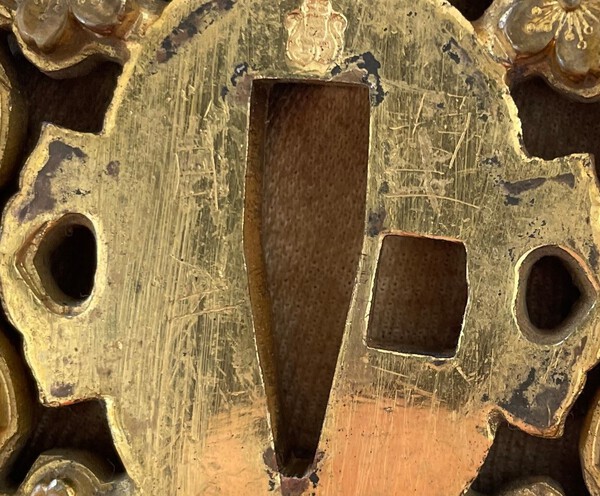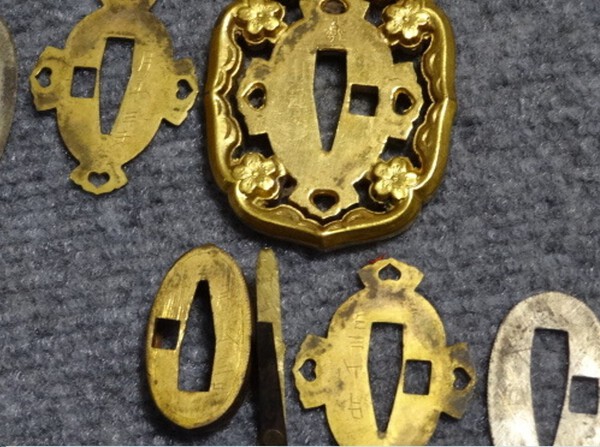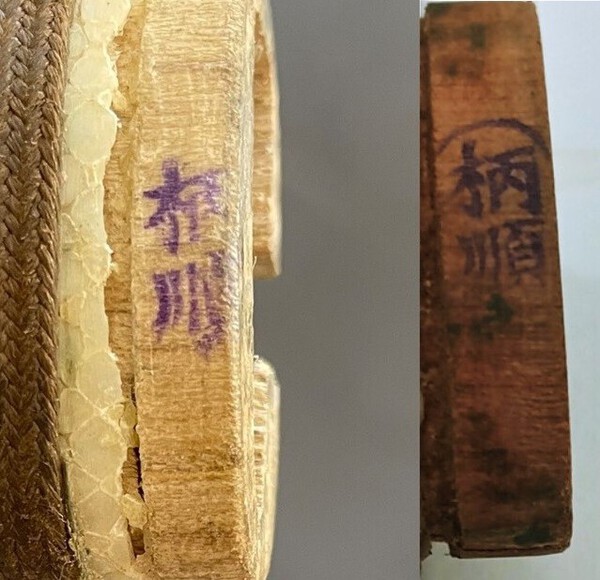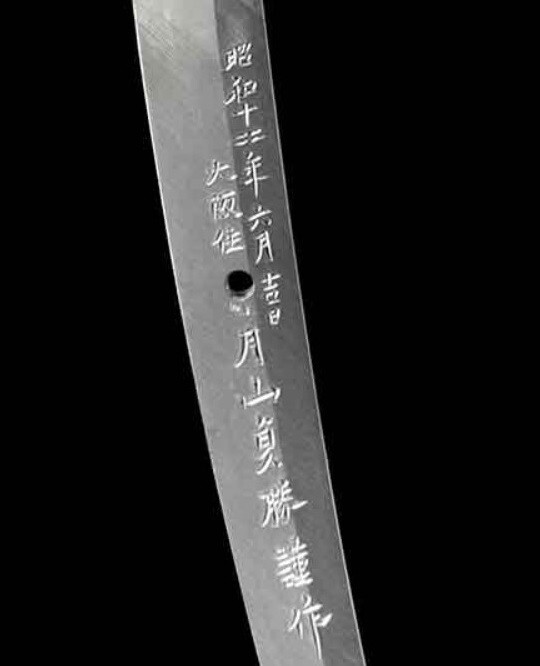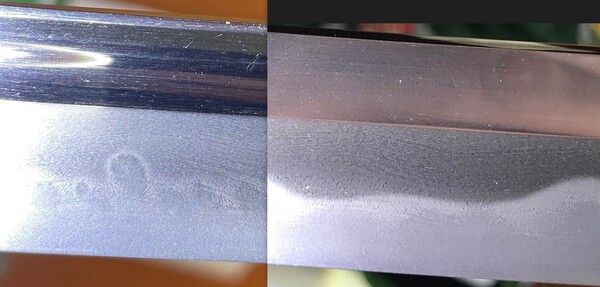-
Posts
742 -
Joined
-
Last visited
-
Days Won
14
Content Type
Profiles
Forums
Events
Store
Downloads
Gallery
Everything posted by Bryce
-
G'day Guys, I realise now that when Gassan Sadakatsu is referring to a blade as Soshu den or Bizen den he is only referring to the hamon style rather than the hada. Thus you see blades described by him as Soshu den with hada ranging from "standing out" itame, thru to pure masame and even very tight koitame. Here is the hamon from the 1938 boxed gunto example posted above. Cheers, Bryce
-
Thanks Steve. Cheers, Bryce
-
-

Gassan Sadatoshi Exhibition
Bryce replied to tom's topic in Sword Shows, Events, Community News and Legislation Issues
Wow, Thanks for posting that Tom. It showcased some beautiful blades. I love this horimono. Cheers, Bryce- 1 reply
-
- 3
-

-

A survey of markings on Suya Shoten swords
Bryce replied to PNSSHOGUN's topic in Military Swords of Japan
G'day Trystan, I agree. I took it as confirmation that I was reading the scratched kanji correctly. It is written in the same gold paint the fuchi is decorated with. I assume this means it was done when the fuchi was painted. There doesn't seem to be anything out of the ordinary about the koshirae, so I wonder what the '特二' is referring to? Could it be referring to the "Gassan" habaki? Cheers, Bryce -

A survey of markings on Suya Shoten swords
Bryce replied to PNSSHOGUN's topic in Military Swords of Japan
G'day John, Here is mine again. It is a 1938 Gassan Sadakatsu blade, with Gassan habaki and tachibana mon on kabutogane. I think the markings translate as short for "Gassan 2" and "special 2"? Cheers, Bryce -

Meaning of Kanji and Katakana on fittings
Bryce replied to PNSSHOGUN's topic in Translation Assistance
G'day John, I agree, I think it is the same ink stamp. Cheers, Bryce -

Meaning of Kanji and Katakana on fittings
Bryce replied to PNSSHOGUN's topic in Translation Assistance
G'day John, Mine isn't unique. Here is another example I found on the net. It would be good to see other examples of Suya fittings with known blades. I guess they may have used the blade maker sometimes and the owner at other times? Cheers, Bryce -

Meaning of Kanji and Katakana on fittings
Bryce replied to PNSSHOGUN's topic in Translation Assistance
G'day Guys, I noticed that in the past, Neil has posted some Yasukunito with Suya fittings that also have scratchings on the tsuba and seppa. My Gassan Sadakatsu with Suya fittings has Gassan scratched on them. In this case could the scratching be shorthand for Yasumitsu maybe? Perhaps if other Yasukunito owners could check their gunto fittings we may be able to decipher this? Cheers, Bryce -

Meaning of Kanji and Katakana on fittings
Bryce replied to PNSSHOGUN's topic in Translation Assistance
-
G'day Brian, I will try to put it into a PDF when I get time. G'day Dirk, Below are some photos of Sadakazu mei where I have highlighted the things he consistently did different to Sadakatsu. I made these a while ago for my own notes and they were never meant for outside consumption. Cheers, Bryce
-
G'day Guys, I have spent the last few years studying swords by Gassan Sadakatsu. I thought I might post about a few of the things I have discovered so far. The earliest blade I have seen signed by Sadakatsu for his father Sadakazu was dated 1897 (Meiji 30). The earliest blade I have seen signed by Sadakatsu for his father, but includes his own name was dated 1906 (Meiji 39). The earliest blade I have seen where Sadakatsu signed for himself was dated 1915 (Taisho 4). Below are photos of these mei, and also blades dated 1921, 1938 and 1943 to demonstrate the subtle changes in the way Sadakatsu signed throughout his working life. Most of the photos are from AOIJapan, but the 1915 blade was sold by Henk at Bushidoshop.nl. All of the blades have NBTHK papers. Gassan Sadakatsu was very consistent in the way he signed, but you can see that the way he signed did change over time. I am confident that all of these mei were by him and not by any of his students. Cheers, Bryce
-
G'day Paul, Thank you for the better photos of the kissaki. In your new photos it doesn't look as bad as it did in the old. The geometry of it is off, but this may just be because it is very worn or perhaps it was damaged and reshaped. Cheers, Bryce
-

Unknown significance of chevron design on Sarute
Bryce replied to PNSSHOGUN's topic in Military Swords of Japan
G'day John, Interesting mon on those swords. What are they? Cheers, Bryce -
G'day Paul, Can you please post a close-up photo of the kissaki of your sword. From your original photos it doesn't look very good. Cheers, Bryce
-
-

Gendaito made December 1945???
Bryce replied to Bruce Pennington's topic in General Nihonto Related Discussion
G'day Bruce, Is that date actually Showa 50? Cheers, Bryce -

A Gassan Sadakazu tanto by...
Bryce replied to John C's topic in Auctions and Online Sales or Sellers
G'day John, Nothing about it is "right", not the mei, not the kao, not the date, not the details. Cheers, Bryce -
G'day Guys, Thanks for the help. Good to know about the dodgy copies. Yes it is for a katana. Here are some of the other fittings. Cheers, Bryce
-
G'day Guys, I have a set of koshirae which has fittings that feature a dragon in clouds. The only problem is that the tsuba doesn't match. I think the tsuba may have been swapped out some time in the past. None of the fittings are signed. A Google search produced this image of a tsuba that appears to be a very close match to the rest of the fittings. Can anyone tell me anything about it, or even better where I might find one like this? Cheers, Bryce
-
G'day Thomas, I can see what you are getting at with the example you posted. I am not sure this applies to all of the examples listed. Perhaps the masame is so fine that you can only differentiate the layers when you look really closely? Here is a photo of two examples by Gassan Sadakatsu. From a distance they both appear to be koitame. When you zoom in you can see the masame. Cheers, Bryce
-
G'day Thomas, You have lost me. Can you please explain this a bit more? Cheers, Bryce
-
G'day Alexi, I am no expert, but my favourite smith is Gassan Sadakatsu who produced many works in masame. I think consistency, plenty of jinie and no kitae ware are what I like. The hada can be very tight with little differentiation between layers or more vivid. Both types of hada can showcase the smith's talent. Below is a link to a thread where I show some examples of this. I must admit to still being baffled sometimes by what makes a blade extraordinary compared to just excellent. Perhaps some of the more experienced members may be able to add more insight. Cheers, Bryce
-
G'day Guys, A British sword maker by the name of Henry Osborn tried to revive the "falchion style" point in his cavalry swords of the late 1700's early 1800's, but his idea never really caught on. Here are some examples of his work. Cheers, Bryce









